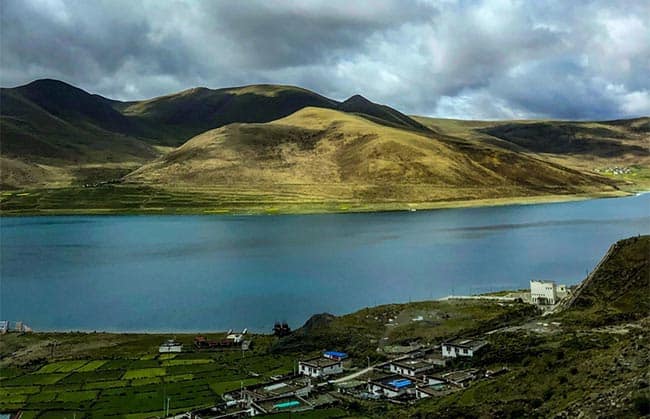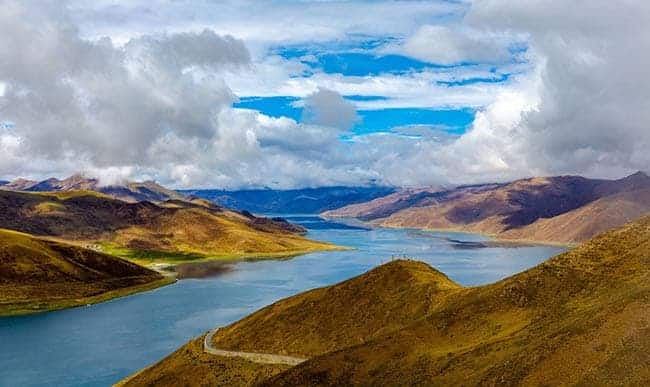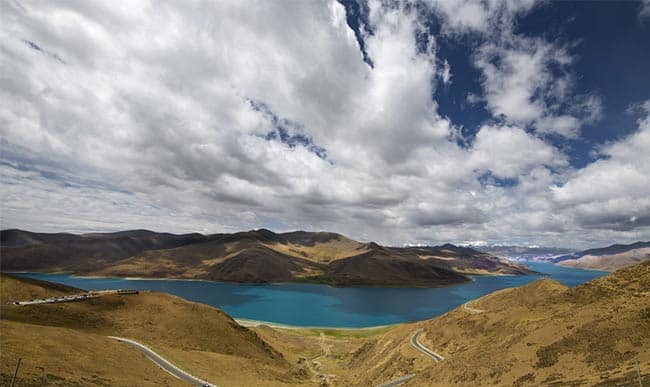Yamdorktso Lake is one of the “Three Holy Lakes in Tibet” (Namtso Lake, Manasarovar Lake and Yamdorktso Lake), bearing the Tibetan meaning “the above coral twig”, corresponding with its shape well. It locates at the Nagarzhag County of Lhoka Prefecture, the south side of the Yarlung Zangbo River. As a plateau Barrier Lake over the sea level about 4441m, Yamdorktso Lake was formed about 100 million years ago due to the choked river way by the glacial debris flow. The water area measures about 630 km2, equal to 70 the West Lake in Hangzhou.
Yamdorktso Lake is famed as “the Most Beautiful Lake in the World” with the literal meaning as “the above coral twig” and the holy moral in Tibetan’s heart as “the Scattered Kallaite Earrings of Fairy” as it couldn’t be gotten its full perspective by visitors on the ground. There are three other lakes creeping on the earth with Yamdorktso Lake, connecting each other together and consisting of an endless holy lake beyond our horizon—the beautiful body of the lake on this land is more than 130km long. When looking it from map or sky, you will surprisingly the lake embedded in this land, glittering like an earring under the sunshine at different time.

This lake bears irregular shape—many branches, winding coastline and three small adjunctive lakes. In the history, it had ever been an exoreic lake with the water flowing into the Yarlung Zangbo River, however it became an endorheic lake due to the shrinkage and broke into several small lakes. Among those divided lakes, there are 21 tiny islands independently standing in the water. The biggest one is about 180,000km2 over where green grass covers and wild bird flock live.
One special feature of this holy lake is its injecting water resource and evaporation. The snow on the Nyenchen Tanglha Mountains supply the endless water for the Yamdork Lake, suffusing the holy lake throughout all years. However, Yamdork Lake has no any outfall—the way how it keep a proper water level is achieving a good balance between inflow and the evaporation naturally.
About Yamdork Lake, devout Buddhist followers regard it as holy lake and spend about one month to make pilgrimages around the lake which is equal to the pilgrim to Lhasa. They could receive bless from Buddha for one year by doing so.
Another legend about Yamdork Lake is its function in assistance to find the reincarnated soul boy. When the old Dalai Lama is dying, the other top monks would follow his order to find his reincarnated soul boy. The first step to find the soul boy is that the wizard and living Buddha to figure out the rough location, then they need to pray and chant at the Yamdork Lake and throw treasures into it for a more detailed instruction for the boy’s location, finally the people who presides over the ritual would see what they want from the lake. If all the steps show the same direction, they would find the reincarnated soul boy accordingly.

The best time to visit Yamdork Lake is autumn and winter, compared with spring and summer, in response to the following three reasons:
- There is no too much rain in autumn and winter days.
- During autumn and winter, there are lots of visitants spend winter at Yamdork Lake.
- The snowy mountains around the lake have their best time in winter and autumn.
Open time: all the days
Entrance fee: CNY40 per person
Note: It is free when appreciating it on the highway or from a long distance while it takes CNY40 per person when travelers need to be close to the lake at the bank or the viewing deck.
Tips:
- Travelers are suggested to take first-aid packet and some commonly used drug during the tour time.
- Tents and sleeping bags are goods suggested to be in your luggage not only for Yamdork Lake tour but also all Tibet tours (except Lhasa). They will help a lot as it is quite cold in the night here.
- You should better prepare some convenient food with high calorie to support your travel here because it is hardly to find good restaurants in the way to this lake.
Please note that taking photos with the yaks at the lake is NOT free although sometimes you wouldn’t see their owners around them. Once you put your shot on them, you will be charged by the local people suddenly coming out. Of course, if you really want to take a photo with those typical Tibetan animals, you can bargain with the local people to get a better price.










